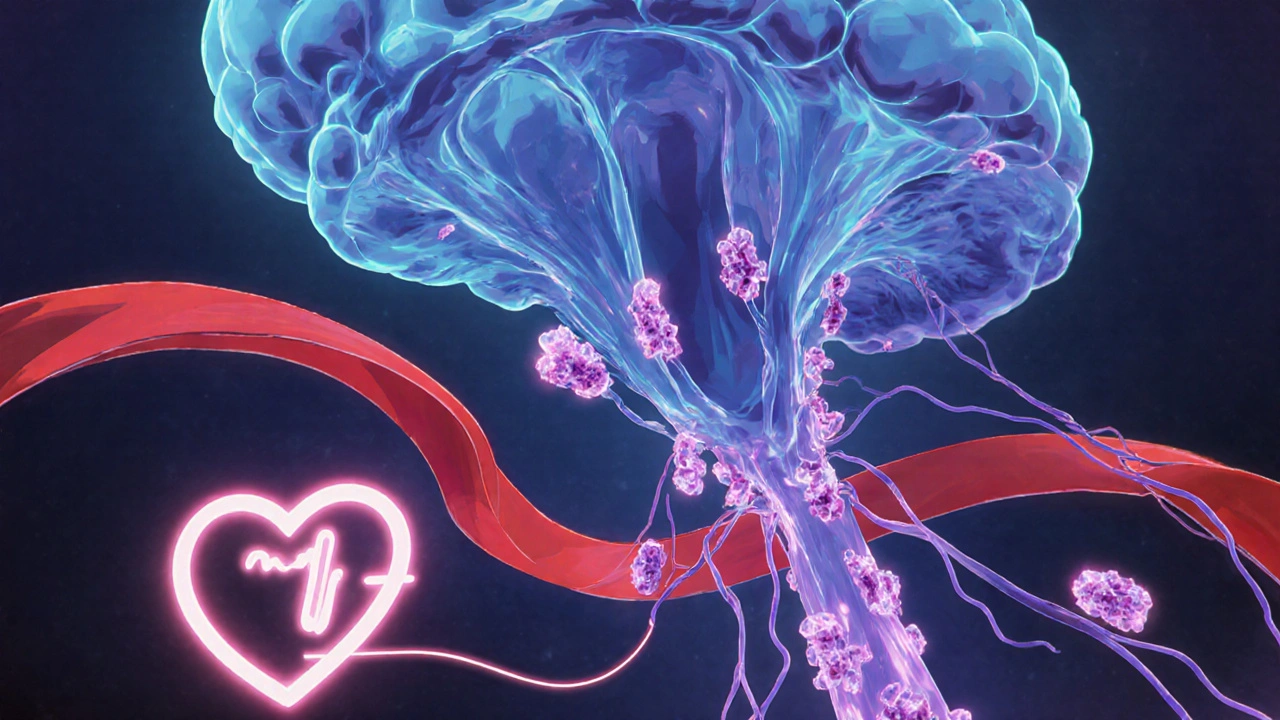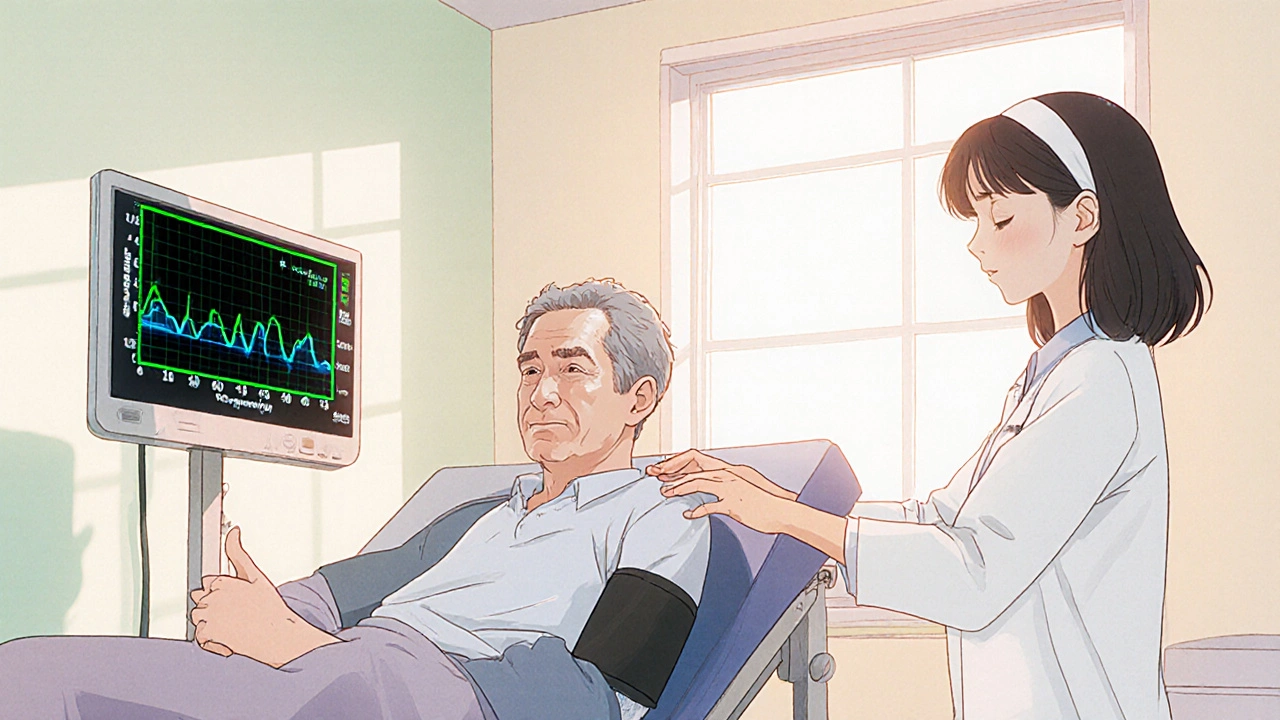Orthostatic Hypotension Diagnostic Calculator
Orthostatic Hypotension Diagnostic Tool
This calculator determines if your blood pressure measurements meet the diagnostic criteria for orthostatic hypotension. According to clinical guidelines, a drop of at least 20 mmHg in systolic pressure or 10 mmHg in diastolic pressure within 3 minutes of standing qualifies as orthostatic hypotension.
When you stand up and feel light‑headed, you might be experiencing Idiopathic Orthostatic Hypotension a sudden drop in blood pressure upon standing without an identifiable cause. For many patients, this symptom is just a nuisance, but research over the past decade shows a deeper connection to Parkinson's Disease a progressive neurodegenerative disorder marked by motor slowness, rigidity, and tremor. Understanding how these two conditions intertwine can help clinicians spot early warning signs and guide patients toward timely treatment.
Why the Link Matters
Both disorders share a common thread: disruption of the Autonomic Nervous System the part of the nervous system that regulates heart rate, blood pressure, and digestion. When this system falters, blood vessels don’t contract enough on standing, leading to the characteristic drop in systolic pressure of at least 20 mmHg or diastolic pressure of 10 mmHg. In Parkinson’s, the same failure often appears as part of a broader autonomic failure that can include urinary urgency, constipation, and sweating abnormalities.
Pathophysiology: From Alpha‑Synuclein to Baroreflex Failure
The culprit protein in Parkinson’s is alpha‑synuclein a misfolded protein that aggregates into Lewy bodies within neurons. When these aggregates deposit in the brainstem, especially in the dorsal motor nucleus of the vagus and the locus coeruleus, they impair the Baroreflex a feedback loop that adjusts heart rate and vessel tone in response to blood pressure changes. The baroreflex blunts, blood vessels stay relaxed, and gravity does the rest-blood pools in the legs and pressure plummets.
Clinical Overlap: Symptoms That Blur the Lines
- Sudden dizziness or faintness within three minutes of standing.
- Blurred vision or “tunnel vision” that improves when you sit back down.
- Fatigue that worsens after prolonged upright posture.
- In Parkinson’s, these are often accompanied by motor signs like bradykinesia and rigidity.
- Supine hypertension-a paradoxical rise in pressure while lying down-can coexist with orthostatic hypotension in both conditions.
Because the symptoms overlap, clinicians sometimes miss the early autonomic signs of Parkinson’s, attributing them solely to blood‑pressure issues.

Diagnostic Strategies: When to Test for Both
Confirming idiopathic orthostatic hypotension (IOH) requires a tilt‑table test or a simple bedside maneuver: measure blood pressure after five minutes supine, then again after three minutes standing. A drop meeting the criteria confirms IOH, but you still need to rule out secondary causes (medications, diabetes, spinal cord injury). If the patient also shows subtle motor changes-shuffling gait, reduced arm swing, or facial masking-a neuro‑evaluation for Parkinson’s is warranted.
Neuroimaging can add confidence. DaT‑SPECT a dopamine transporter scan that reveals loss of dopaminergic neurons in the striatum often shows reduced uptake in early Parkinson’s, even before obvious tremor appears. Combining a positive tilt‑table result with abnormal DaT‑SPECT raises the odds that the orthostatic hypotension is not truly idiopathic but a manifestation of Parkinsonian autonomic failure.
Management: Treating Two Sides of the Same Coin
Therapy begins with non‑pharmacologic measures that benefit both conditions: increase fluid intake to 2-3 L/day, raise salt intake (if no heart‑failure contraindication), and wear compression stockings. Elevating the head of the bed by 10-15 cm can reduce supine hypertension while preserving nighttime blood‑pressure control.
Pharmacologic options differ. For pure IOH, midodrine an alpha‑1 agonist that constricts peripheral vessels is first‑line. In Parkinson’s‑related autonomic failure, droxidopa a synthetic norepinephrine precursor that raises standing blood pressure is often preferred because it also boosts central norepinephrine pathways, potentially improving mood and cognition.
When dopamine‑replacement therapy (levodopa) is started for motor symptoms, watch for an initial dip in blood pressure as peripheral dopamine receptors dilate vessels. Titrating levodopa slowly and monitoring orthostatic vitals can avoid sudden falls.
Prognostic Implications: What the Connection Tells Us
Patients who present with IOH before any motor signs have a higher likelihood of developing Parkinson’s within five years-studies from 2022 to 2024 report conversion rates of 15‑30 %. This suggests that orthostatic hypotension can be an early, non‑motor biomarker of neurodegeneration. Recognizing the pattern enables earlier referral to movement‑disorder specialists, where disease‑modifying trials (e.g., alpha‑synuclein antibodies) are now enrolling.
Conversely, individuals with long‑standing Parkinson’s who develop IOH often face a steeper decline in quality of life, as falls become more frequent and medication adherence suffers.

Key Takeaways for Clinicians and Patients
- Always measure standing blood pressure in patients with unexplained dizziness, even if they have a known neurodegenerative disease.
- Consider autonomic testing when orthostatic symptoms appear before motor signs; early detection can guide enrollment in neuroprotective studies.
- Use a stepwise treatment plan: lifestyle changes first, then midodrine for pure IOH or droxidopa when Parkinson’s is present.
- Monitor for supine hypertension, especially after starting medications that raise standing pressure.
- Educate patients about fall‑prevention strategies-slowly rise from sitting, keep hydrated, and avoid hot environments.
Comparison of Core Features
| Feature | Idiopathic Orthostatic Hypotension | Parkinson’s Disease (autonomic) |
|---|---|---|
| Primary cause | Unknown; often primary vascular dysregulation | Alpha‑synuclein deposition in brainstem autonomic nuclei |
| Typical onset age | 50‑70 years | 55‑75 years (motor signs may appear later) |
| Associated motor symptoms | None | Bradykinesia, rigidity, tremor |
| Supine hypertension | Present in ~30 % | Present in ~40 % |
| Response to midodrine | Good | Variable; may worsen supine hypertension |
| Progression to neurodegeneration | 15‑30 % develop Parkinson’s within 5 years | Progressive neurodegeneration inherent |
Frequently Asked Questions
What tests confirm idiopathic orthostatic hypotension?
A bedside tilt test (measure supine BP, then standing BP after three minutes) is the gold standard. A drop of ≥20 mmHg systolic or ≥10 mmHg diastolic confirms the diagnosis. If secondary causes are suspected, labs (CBC, metabolic panel) and medication review are added.
Can Parkinson’s disease cause orthostatic hypotension even before motor symptoms?
Yes. Autonomic failure can precede motor signs by years. Early orthostatic dizziness, constipation, and loss of smell are red flags that should prompt a neurologic evaluation.
What lifestyle changes help both conditions?
Increase fluid intake to 2-3 L/day, add 1‑2 g of salt (if no cardiac restriction), wear compression stockings, elevate the head of the bed, and avoid prolonged standing or hot baths.
Is midodrine safe for Parkinson’s patients?
Midodrine can raise standing pressure but may worsen supine hypertension. In Parkinson’s‑related autonomic failure, droxidopa is usually preferred, though some clinicians combine low‑dose midodrine with careful monitoring.
How often should blood pressure be checked in Parkinson’s patients?
At least twice daily-once in the morning after waking (supine) and again after standing for three minutes. More frequent checks are advised when starting or adjusting vasoactive medications.
By seeing orthostatic hypotension not as an isolated blood‑pressure issue but as a possible early warning sign of Parkinson’s, doctors can intervene sooner and patients can take steps to stay safe while standing. The link is real, the evidence is growing, and the treatment toolbox is expanding.

Jinny Shin
October 24, 2025 AT 12:00While the clinical details read like a meticulously crafted symphony, the reality for patients is often a silent drama that unfolds each morning when they rise. The juxtaposition of idiopathic orthostatic hypotension with early Parkinsonian signs beckons a nuanced appreciation of autonomic failure. Recognizing this overlap can transform a vague complaint into a predictive biomarker. Thus, clinicians must tune their diagnostic ear to the subtle cadence of blood‑pressure shifts.
Jennell Vandermolen
November 3, 2025 AT 21:00It's helpful to remember that simple measures-like staying hydrated and using compression stockings-can make a big difference. Pair those with regular orthostatic BP checks and you give patients a solid foundation before any pharmacologic step. This approach respects the patient's daily life while still being thorough.
Heather ehlschide
November 14, 2025 AT 07:00The baroreflex arc serves as the central governor of circulatory stability, integrating afferent signals from carotid and aortic stretch receptors and modulating sympathetic outflow accordingly. In idiopathic orthostatic hypotension, the intrinsic gain of this reflex is markedly reduced, leading to insufficient vasoconstriction upon upright posture. When alpha‑synuclein aggregates deposit in the nucleus tractus solitarius and the dorsal motor nucleus of the vagus, the same reflex circuitry becomes compromised, which is a hallmark of Parkinsonian autonomic failure. This neuropathological convergence explains why patients may present with dizziness before any tremor is evident. Empirical tilt‑table testing quantifies the hemodynamic drop, but it does not differentiate primary from secondary autonomic degeneration. Adding a DaT‑SPECT scan provides a neurochemical window, revealing presynaptic dopaminergic loss even in the absence of motor signs. The combination of a positive tilt test and reduced striatal uptake raises the pre‑test probability of an underlying synucleinopathy. Clinicians should therefore consider ordering both studies when orthostatic symptoms are unexplained and subtle bradykinesia is observed. From a therapeutic standpoint, lifestyle interventions remain the cornerstone; increasing fluid intake to three liters per day and elevating the head of the bed can mitigate supine hypertension while supporting standing pressures. Pharmacologically, midodrine targets peripheral alpha‑1 receptors, which is effective in pure idiopathic cases but may exacerbate nocturnal hypertension in Parkinsonian patients. Droxidopa, on the other hand, augments central norepinephrine stores and has the added benefit of modest cognitive enhancement. Initiating levodopa for motor control requires careful titration because peripheral dopamine can cause vasodilation, temporarily worsening orthostatic drops. Regular monitoring of supine and standing blood pressures after each dosage adjustment is essential to avoid falls. Over the ensuing five years, longitudinal studies have shown that 20 % of individuals with isolated orthostatic hypotension develop clinically definite Parkinson’s disease, underscoring its value as an early biomarker. Conversely, patients with long‑standing Parkinson’s who acquire orthostatic hypotension experience a steeper decline in activities of daily living, largely due to fall‑related injuries. Ultimately, recognizing the bidirectional link empowers clinicians to intervene earlier, enroll patients in neuroprotective trials, and tailor therapy to the dual challenges of blood‑pressure regulation and motor dysfunction.
Kajal Gupta
November 24, 2025 AT 17:00Yo, think of the nervous system as that over‑caffeinated DJ at a rave-when it glitches, the beat drops and you literally feel the floor wobble. Orthostatic hypotension is just the body’s way of saying, “Hey, I need a better bass line!” If you’ve got Parkinson’s in the mix, that DJ’s playlist is corrupted with alpha‑synuclein tracks that mess up the baroreflex groove. Simple tricks like slurping a big glass of water or rocking those classy compression socks can keep the rhythm steady. And if the party’s still off‑beat, doctors have a stash of meds-midodrine for the pure hypotension crew, droxidopa when Parkinson’s is throwing its own wild remixes. Bottom line: stay hydrated, stay moving, and don’t let the blood‑pressure beats skip.
Zachary Blackwell
December 5, 2025 AT 03:00Ever notice how the big pharma giants love to push dopamine pills while quietly ignoring the blood pressure drops that come with them? It’s like they want us glued to a pill bottle and not question why we’re dizzy when we stand. The link between orthostatic hypotension and Parkinson’s isn’t just a coincidence-it’s a hidden pathway they don’t want the public to see. Keep an eye on your own vitals, stay off the “miracle” meds until you’ve read the fine print, and demand full autonomic testing before any diagnosis is stamped.
prithi mallick
December 15, 2025 AT 13:00i think its really importent to rememeber that tought awsome research shows a strong link between low blood pressure on stand and early markers of parkinson. patients should be encourged to check there vitals regularily and not ignore the light headed fealings. also, simple changes like adding a pinch of salt or wearing spport stockings can help a lot. its a sad thing that many docs miss these sign because they focus only on tremor and miss the real story.
Michaela Dixon
December 25, 2025 AT 23:00The human body, in all its magnificent complexity, orchestrates a delicate ballet of pressure gradients, vascular tone, and neural signaling with every shift from supine repose to upright poise. When the autonomic maestro falters, as it does in idiopathic orthostatic hypotension, the choreography collapses and blood pools like a reluctant tide in the lower extremities. What is truly fascinating, however, is how this very collapse serves as a prelude to the more ominous symphony of Parkinson’s disease, where misfolded alpha‑synuclein infiltrates the brainstem’s very conductors. Imagine the baroreflex as a vigilant sentinel, its signals dulled by synuclein clouds, leaving the cardiovascular system adrift. In clinical practice, a simple tilt‑table test can unmask this hidden discord, while a DaT‑SPECT scan paints a vivid portrait of dopaminergic loss. The therapeutic arsenal, ranging from the vasoconstrictive punch of midodrine to the norepinephrine‑boosting finesse of droxidopa, offers clinicians a palette of options. Yet, the most elegant stroke remains the patient‑centered regimen of hydration, salt, and compression garments, which together rewrite the script of daily dizziness. As researchers continue to map the intertwining pathways of autonomic failure and neurodegeneration, each discovery adds a new brushstroke to our collective understanding. In the meantime, empowering patients with knowledge about early warning signs transforms uncertainty into proactive care.